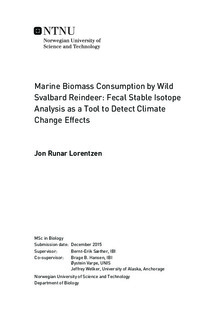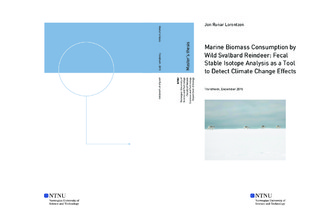| dc.description.abstract | Climate change in the Arctic is becoming evident with increased winter temperatures and changes in precipitation already perturbing Arctic ecosystems. Warm spells with rainfall in winter, also known as rain on snow (ROS) events, allow accumulation of ice on the tundra, hindering arctic herbivores access to preferred forage. Observations of the Svalbard reindeer (Rangifer tarandus platyrhynchus) in the high Arctic archipelago of Svalbard might indicate utilization of marine food sources during winters with severe icing conditions. Here I used spatially mapped population monitoring data from nine winters to first test the hypothesis that kelp and seaweed are utilized more frequently during years with heavy ROS and accumulated tundra ice. I find support for the hypothesis based on a positive correlation between proportion of animals foraging along the shore and the amount of tundra ice the respective winter. Second, I do stable isotope analysis (SIA) on fecal and kelp samples to assess new methods for monitoring such changes in the realized foraging niche among high arctic ungulates. δ13C values were significantly higher for kelp and feces from the two marine feeder groups than feces from the two terrestrially feeding groups. For δ34S, with three analyzed categories, including kelp and the two considered extremes, there were no significant difference between kelp and feces from reindeer feeding on kelp, but significantly lower and non-overlapping values for feces from terrestrial feeders. Large variations in δ15N values within terrestrial fecal samples and large overlap among sample groups (kelp and the different fecal groups) dismiss Nitrogen as a viable option. Thus, δ13C and δ34S values represent the best indicators distinguishing between marine and terrestrial forage origins. These results emphasize the importance of monitoring changes in foraging behavior as a mean to predict effects of the expected increase in ROS-events in circumpolar regions. SIA on feces may provide a cost-efficient, non-invasive tool to better achieve this and could easily be implemented in current and future research and monitoring programs. | |

